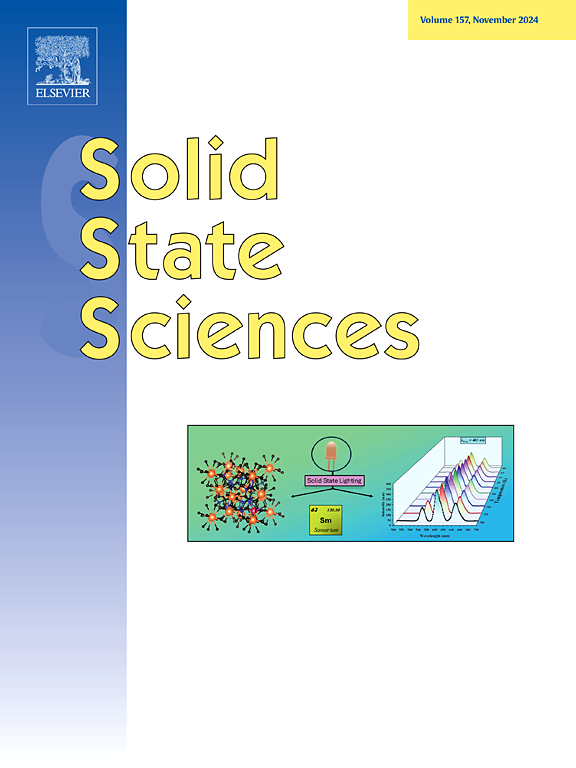In-depth insights into the evolution of NiFeCrCu multicomponent alloy in the course of the catalytic growth of carbon nanofibers
IF 3.3
3区 化学
Q2 CHEMISTRY, INORGANIC & NUCLEAR
引用次数: 0
Abstract
Multicomponent alloys attract growing attention to be applied in various fields of science and technology. In the present study, Ni52Fe22Cr15Cu11 alloy was produced via a single-stage method of electric explosion of wire. It was shown that this method makes it possible to obtain a phase-pure powder (solid solution with a fcc structure, a = 3.583 Å) consisting of spherical nanoparticles with an average diameter of ∼70 nm. According to chemical analysis data, the formed alloy nanoparticles are close in composition to the target ratio of metals. Depending on the treatment procedures such as reduction in hydrogen, heating in argon, calcination in air, and catalytic chemical vapor deposition of C2-C4 hydrocarbons, the alloy undergoes different changes. The evolution of the phase composition and magnetic properties of the alloy was monitored using X-ray diffraction analysis and ferromagnetic resonance spectroscopy. As found, the alloy exhibits the phase stability while treating in argon only. Its treatment in hydrogen at temperatures of 500 °C and above facilitates the damage of the solid solution. During the catalytic chemical vapor deposition process performed at 650 °C for 30 min, the carbon yield reached the value of 42 g/gcat. According to transmission electron microscopy, the morphology of the deposited carbon is represented by a set of nanofibers with a mosaic structure. The resulting carbon nanofibers have a specific surface area of ∼330 m2/g and a pore volume of ∼0.8 cm3/g.

深入了解NiFeCrCu多组分合金在纳米碳纤维催化生长过程中的演化
多组分合金在各个科学技术领域的应用日益受到人们的重视。本研究采用单级电爆丝法制备了Ni52Fe22Cr15Cu11合金。结果表明,这种方法可以获得由平均直径为~ 70 nm的球形纳米颗粒组成的相纯粉末(具有fcc结构的固溶体,a = 3.583 Å)。化学分析数据表明,所制备的纳米合金在成分上接近金属的目标比。根据不同的处理程序,如氢气还原、氩气加热、空气煅烧和催化化学气相沉积C2-C4碳氢化合物,合金会经历不同的变化。利用x射线衍射分析和铁磁共振谱技术监测了合金的相组成和磁性能的演变。结果表明,该合金仅在氩气中处理时表现出相稳定性。在500°C及以上的温度下在氢气中处理有利于固溶体的破坏。在650℃、30 min的催化化学气相沉积过程中,碳得率达到42 g/gcat。通过透射电镜观察,沉积碳的形貌表现为一组具有马赛克结构的纳米纤维。所得的碳纳米纤维的比表面积为~ 330 m2/g,孔体积为~ 0.8 cm3/g。
本文章由计算机程序翻译,如有差异,请以英文原文为准。
求助全文
约1分钟内获得全文
求助全文
来源期刊

Solid State Sciences
化学-无机化学与核化学
CiteScore
6.60
自引率
2.90%
发文量
214
审稿时长
27 days
期刊介绍:
Solid State Sciences is the journal for researchers from the broad solid state chemistry and physics community. It publishes key articles on all aspects of solid state synthesis, structure-property relationships, theory and functionalities, in relation with experiments.
Key topics for stand-alone papers and special issues:
-Novel ways of synthesis, inorganic functional materials, including porous and glassy materials, hybrid organic-inorganic compounds and nanomaterials
-Physical properties, emphasizing but not limited to the electrical, magnetical and optical features
-Materials related to information technology and energy and environmental sciences.
The journal publishes feature articles from experts in the field upon invitation.
Solid State Sciences - your gateway to energy-related materials.
 求助内容:
求助内容: 应助结果提醒方式:
应助结果提醒方式:


